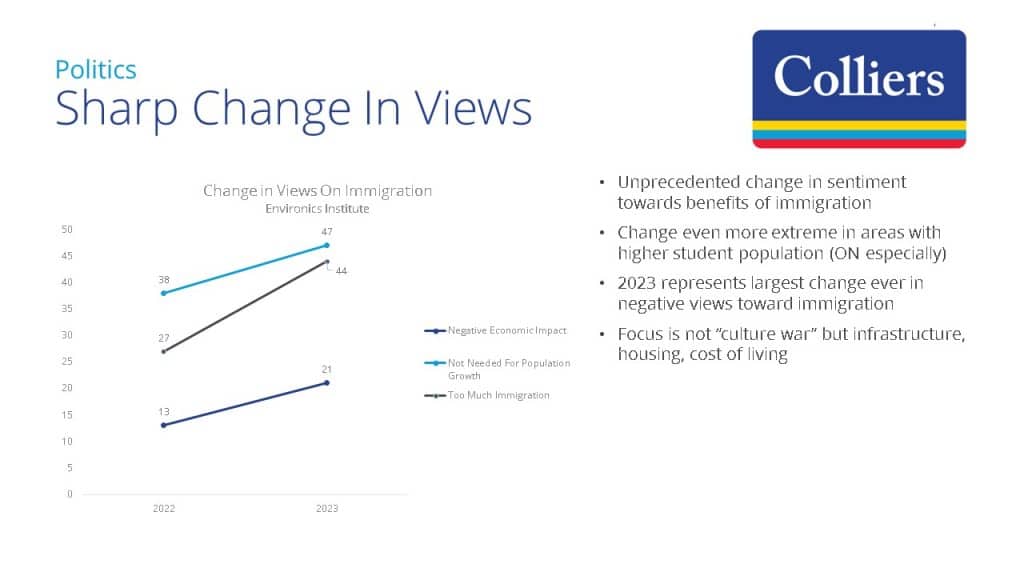
A fiery session of investors, researchers, and government executives at SHURE GTA concluded that the Canadian federal government needs to be more involved in funding housing creation and bringing back the fourplex housing model.
Don’t blame international students: Canadian views of immigration shift due to high inflation and the lack of housing
January 5, 2024
Canadian post-secondary institutions have benefited substantially in recent years from the surge in international student enrollment. However, faced with criticism over the lack of affordable housing for Canadian residents, the Housing Minister has recently discussed limiting the number of international students. An international student cap may benefit the Country's housing crisis for its general population and help lower costs, but it impacts capital raising for post-secondary institutions.
 Related SHURE Initiative Content | Doctor of Student Housing: Pay attention to the ‘trends within the trends’ for 2024
Related SHURE Initiative Content | Doctor of Student Housing: Pay attention to the ‘trends within the trends’ for 2024
As such, The SHURE Initiative convened a sometimes controversial discussion about balancing housing affordability for native residents and the benefits that international students bring to the Country's post-secondary system. Despite being controversial, many SHURE attendees at the Toronto conference viewed the discussion on a pressing topic as necessary.

Aly Damji, Managing Partner, Real Estate, Forum Asset Management
Aly Damji, a Managing Partner at Forum Asset Management, commanded the discussion. Damji opened his remarks with compelling statistics of Canada's severe housing crunch.
"A major topic this year that most of us are encountering is the surge in international student enrollment. Simultaneously, the government is looking at potentially capping the number of international students to maintain housing for its population, so this is a big current topic," noted Damji.
While 800,000 student visas were issued in Canada in 2022, the Country's fertility rate stood at 1.33%, among the lowest in the world, according to Damji's information, showing that immigration growth is essential to Canada.
The road to citizenship via higher education is a path the federal and regional governments are eager to promote. International students rose from 46,000 to 412,000 between 2000 and 2022. Provinces such as Ontario put tuition freezes on universities and colleges for domestic students, leaving no option for these institutions to do anything but open doors to higher revenue-generating international students.
Damji was very stern in his comments about the tight housing conditions in Canada. "Our national vacancy rate is about 1.9%, as reported by CMHC in 2022. Given the current market, I'm pretty sure it'll drop, and it's the lowest in decades. Major centers with large university bases, such as Toronto, have vacancy rates less than 1%. The problem is more severe in small university towns like Guelph, with a sub-1 % vacancy rate."
However, there is a sea change in Canadian views of immigration and international students. Following the pandemic and record-high inflation, a survey shows Canadians are less supportive of immigration.

Adam Jacobs, Senior National Director, Research - Canada, Colliers
"Canadian attitudes toward immigration have changed, and they don't usually change drastically year to year, but they are now," warned Adam Jacobs, Senior National Director, Research - Canada, Colliers.
According to Jacobs's research, there has been a dramatic change in immigration views in the last year, likely due to interest rate hikes, inflation, and the lack of affordability in the market. "I was shocked to see how dramatic that change was in opinions to immigration, and the report makes it quite clear this isn't the culture war that other Western countries are dealing with; this is not, we don't like the religion of immigrants," said Jacobs.

"Unprecedented" is the rapid change in Canadians' view of immigration, according to Adam Jacobs of Colliers.
Jacobs thinks the change in views is due to the cost of living and interest rate hikes, noting that other significant challenges, such as recovery from 9/11 and the financial crisis, did not impact views. "It's amazing how 12 rate hikes can change people's opinion on immigration and housing and politics and Justin Trudeau and everything in about in one year, but that's what we're seeing," exclaimed Jacobs.

Tony Irwin, President & CEO, FRPO (Federation of Rental-housing Providers of Ontario)
Tony Irwin, President and CEO of Ontario's Federation of Rental-housing Providers, acknowledges a massive housing crisis and that increasing rental supply is an enormous part of the solution. He said the challenge is getting the attention of the federal government. "So it's been more provincial municipal governments that have been involved until now. I would say the federal government is now trying to get into the act because it's incumbent that every government does. And, of course, the crisis has finally gotten widespread attention," according to Irwin.
However, the panelists agreed that Canada needs international students, thus creating the debate. Should the government limit international student enrollment to preserve housing for its citizens? Many universities and colleges rely on the added income that international students bring to their institutions.

Peter Milczyn B.Arch., MRAIC, Principal, PM Strategies Inc
Peter Milczyn B.Arch., MRAIC, Principal, PM Strategies Inc., suggested that the federal government, which was more involved in housing in prior decades in Canada but has been absent recently, needs to get more involved. Milczyn said the housing Crisis has been 40 years in the making.
"The federal government, which was a solid player in the creation of new housing through the Canada Mortgage Mortgage and Housing Corporation through a variety of programs and initiatives and tax policies that promoted the construction of rental housing and the construction of housing, but the federal government got out of that in the 1980s and early 90s," according to Milczyn.
Canada grew exponentially after World War II, and housing was always available due to government programs and incentives. "I'd say precisely because the federal government did take a leadership role, but they vacated that, now fast forward to today and student housing in particular, so we have a housing crisis for everyone," according to Milczyn.
The panelists agreed that municipal governments have been more active in addressing the housing crisis, but the federal government would make the bigger difference.
"My view is that the federal government has all the power," exclaimed Damji of Forum Asset Management. "In my view, HST, too late to the game, CMHC controls the Federal Housing Agency, which up until recently was suffering from months of paralysis to complete any sort of applications so that owners could recycle capital and build more housing," said Damji.
However, Damji was somewhat sympathetic to the layers of Canadian government. "Funding from the feds to these municipalities, we can't blame them, they are cash strapped. Look at Toronto's big budget deficit," said Damji.
In the meantime, Jacobs of Colliers said it's important not to blame immigration, especially students who are an easy target in this crisis and when a hard time comes for housing.
"And if we're talking about a vacancy rate that's in the single digits below 1%, that is enough to swing a market and make people notice the difference and move from a balanced market to a landlord's market to the market that we have now, which is desperation on all sides," according to Jacobs.
As for proactive solutions, Milczyn suggested permitting times must be shortened, and the feds might want to get behind the concept of fourplex housing layouts.
"The idea is to take a higher yield per square foot from those buildings, not run into a lot of red tape and hand wringing from municipalities, and create housing that would house more students, at a higher yield per square foot, which makes it more viable to build," according to Milczyn.
While interest rates may be challenging, construction delays might be more problematic, according to Irwin of FRPO. "We have to be more efficient on how we do this; you can't take 5, 6, or 10 years to get projects going. That's unacceptable, especially in a crisis like we're in now."
 Continue reading with your SHURE membership account.
Continue reading with your SHURE membership account.
This full-length story, industry research, and data analytics are available exclusively to SHURE members.
- Unlimited access to SHURE.international
- Unlimited access to SHURE analytics covering university real estate and student accommodation trends
- Member-only newsletters and industry announcements
